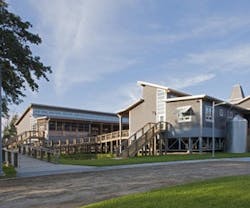Grand Bay Coastal Resources Center Strengthens Commitment to Environment
Located on an isolated reserve on the Mississippi Gulf Coast, the Grand Bay Coastal Resources Center is minimizing its environmental impact, which recently earned the facility LEED-Gold. The $7 million, 20,000-square-foot center is “a green demonstration facility that teaches through its architecture what sustainable design is about, showing how to develop land responsibly in sensitive areas,” said Jim Nicolow, director of sustainability at Lord, Aeck & Sargent, an architecture firm.
The new facility promotes stewardship of coastal resources using an integrated program of research, long-term monitoring, training, and education. Because it is located in a hurricane-prone area, the building is elevated 19.5 feet above sea level on a framework of galvanized steel trusses that sit atop pilings. This is a more environmentally friendly approach than bringing in dirt fill to raise the site, which would have altered its natural hydrology.
Nitrogen loading from failing septic systems represents a key environmental threat to the estuary. The Center boasts a greener alternative to conventional septic systems: an on-site, self-contained bio-filtration wastewater system that can treat up to 1,200 gallons of water daily uses aerobic bacteria to treat the building’s wastewater to tertiary standards.
The building is also constructed from environmentally friendly materials. The exterior siding, which looks like cedar shake, is actually made of 95 percent recycled plastics, fiber and rubber. Beneath the siding is a baseband of fiber cement made from recycled wood fiber.
Another important sustainable aspect of the building’s design is its resiliency features, which protect against damage or destruction from fire and hurricanes. Nicolow says, “with its elevated structure, extensive daylighting, operable windows with interior no-see-um screens (to keep them from blowing off during a hurricane) for passive ventilation, the building is habitable, even when power is interrupted for extended periods.”
